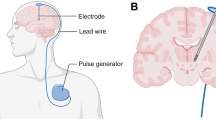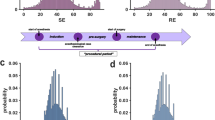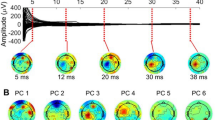Abstract
Computational models have been be used to estimate the electric and magnetic fields induced by transcranial magnetic stimulation (TMS) and can provide valuable insights into the location and spatial distribution of TMS stimulation. However, there has been little translation of these findings into practical TMS research. This study uses the International 10-20 EEG electrode placement system to position a standard figure-of-eight TMS coil over 13 commonly adopted targets. Using a finite element method and an anatomically detailed and realistic head model, this study provides the first pictorial and numerical atlas of TMS-induced electric fields for a range of coil positions. The results highlight the importance of subject-specific gyral folding patterns and of local thickness of subarachnoid cerebrospinal fluid (CSF). Our modelling shows that high electric fields occur primarily on the peaks of those gyri which have only a thin layer of CSF above them. These findings have important implications for inter-individual generalizability of the TMS-induced electric field. We propose that, in order to determine with accuracy the site of stimulation for an individual subject, it is necessary to solve the electric field distribution using subject-specific anatomy obtained from a high-resolution imaging modality such as MRI.






Similar content being viewed by others
References
Barker AT, Jalinous R, Freeston IL (1985) Non-invasive magnetic stimulation of human motor cortex. Lancet 1(8437):1106–1107
Thickbroom GW (2007) Transcranial magnetic stimulation and synaptic plasticity: experimental framework and human models. Exp Brain Res 180(4):583–593
Walsh V, Cowey A (2000) Transcranial magnetic stimulation and cognitive neuroscience. Nat Rev Neurosci 1(1):73–80
Hallett M (2007) Transcranial magnetic stimulation: a primer. Neuron 55(2):187–199
O’Shea J, Walsh V (2007) Transcranial magnetic stimulation. Curr Biol 17(6):R196–R199
Wassermann EM, Wang B, Zeffiro TA, Sadato N, Pascual-Leone A, Toro C et al (1996) Locating the motor cortex on the MRI with transcranial magnetic stimulation and PET. NeuroImage 3(1):1–9
Amassian VE, Maccabee PJ, Cracco RQ, Cracco JB, Somasundaram M, Rothwell JC et al (1994) The polarity of the induced electric field influences magnetic coil inhibition of human visual cortex: implications for the site of excitation. Electroencephalogr Clin Neurophysiol 93(1):21–26
Maccabee PJ, Amassian VE, Eberle LP, Cracco RQ (1993) Magnetic coil stimulation of straight and bent amphibian and mammalian peripheral nerve in vitro: locus of excitation. J Physiol 460:201–219
Cohen LG, Roth BJ, Nilsson J, Dang N, Panizza M, Bandinelli S et al (1990) Effects of coil design on delivery of focal magnetic stimulation. Technical considerations. Electroencephalography and Clinical Neurophysiology. 75(4):350–357
Ueno S, Tashiro T, Harada K (1988) Localized stimulation of neural tissue in the brain by means of a paired configuration of time-varying electric fields. J Appl Phys 64(10):5862–5864
Salinas FS, Lancaster JL, Fox PT (2009) 3D modeling of the total electric field induced by transcranial magnetic stimulation using the boundary element method. Phys Med Biol 54(12):3631–3647
Stokes MG, Chambers CD, Gould IC, English T, McNaught E, McDonald O et al (2007) Distance-adjusted motor threshold for transcranial magnetic stimulation. Clin Neurophysiol 118(7):1617–1625
Toschi N, Welt T, Guerrisi M, Keck ME (2008) A reconstruction of the conductive phenomena elicited by transcranial magnetic stimulation in heterogeneous brain tissue. Phys Med. 24(2):80–86
Barker AT, Garnham CW, Freeston IL (1991) Magnetic nerve stimulation: the effect of waveform on efficiency, determination of neural membrane time constants and the measurement of stimulator output. Electroencephalogr Clin Neurophysiol Suppl 43:227–237
Jalinous R (1991) Technical and practical aspects of magnetic nerve stimulation. J Clin Neurophysiol 8(1):10–25
Kammer T, Beck S, Thielscher A, Laubis-Herrmann U, Topka H (2001) Motor thresholds in humans: a transcranial magnetic stimulation study comparing different pulse waveforms, current directions and stimulator types. Clin Neurophysiol Off J Int Fed Clin Neurophysiol 112(2):250–258
Wolf SL, Butler AJ, Campana GI, Parris TA, Struys DM, Weinstein SR et al (2004) Intra-subject reliability of parameters contributing to maps generated by transcranial magnetic stimulation in able-bodied adults. Clin Neurophysiol Off J Int Fed Clin Neurophysiol 115(8):1740–1747
Dubach P, Guggisberg AG, Rösler KM, Hess CW, Mathis J (2004) Significance of coil orientation for motor evoked potentials from nasalis muscle elicited by transcranial magnetic stimulation. Clin Neurophysiol 115(4):862–870
Lisanby SH, Gutman D, Luber B, Schroeder C, Sackeim HA, Sham TMS (2001) Intracerebral measurement of the induced electrical field and the induction of motor-evoked potentials. Biol Psychiatry 49(5):460–463
Wagner T, Gangitano M, Romero R, Théoret H, Kobayashi M, Anschel D et al (2004) Intracranial measurement of current densities induced by transcranial magnetic stimulation in the human brain. Neurosci Lett 354(2):91–94
Bestmann S, Baudewig J, Siebner HR, Rothwell JC, Frahm J (2004) Functional MRI of the immediate impact of transcranial magnetic stimulation on cortical and subcortical motor circuits. Eur J Neurosci 19(7):1950–1962
Bohning DE, Shastri A, Nahas Z, Lorberbaum JP, Andersen SW, Dannels WR et al (1998) Echoplanar BOLD fMRI of brain activation induced by concurrent transcranial magnetic stimulation. Invest Radiol 33(6):336–340
Paus T, Jech R, Thompson CJ, Comeau R, Peters T, Evans AC (1997) Transcranial magnetic stimulation during positron emission tomography: a new method for studying connectivity of the human cerebral cortex. J Neurosci 17(9):3178–3184
Paus T, Sipila PK, Strafella AP (2001) Synchronization of neuronal activity in the human primary motor cortex by transcranial magnetic stimulation: an EEG study. J Neurophysiol 86(4):1983–1990
Salinas FS, Szabo CA, Zhang W, Jones L, Leland MM, Wey H-Y et al (2011) Functional neuroimaging of the baboon during concurrent image-guided transcranial magnetic stimulation. Neuroimage 57(4):1393–1401
Roth BJ, Cohen LG, Hallett M (1991) The electric field induced during magnetic stimulation. Electroencephalogr Clin Neurophysiol Suppl 43:268–278
Roth BJ, Saypol JM, Hallett M, Cohen LG (1991) A theoretical calculation of the electric field induced in the cortex during magnetic stimulation. Electroencephalogr Clin Neurophysiol 81(1):47–56
Tofts PS (1990) The distribution of induced currents in magnetic stimulation of the nervous system. Phys Med Biol 35(8):1119–1128
Cohen D, Cuffin BN (1991) Developing a more focal magnetic stimulator. Part I: some basic principles. J Clin Neurophysiol 8(1):102–111
Ravazzani P, Ruohonen J, Grandori F, Tognola G (1996) Magnetic stimulation of the nervous system: induced electric field in unbounded, semi-infinite, spherical, and cylindrical media. Ann Biomed Eng 24(5):606–616
Wagner T, Zahn M, Grodzinsky AJ, Pascual-Leone A (2004) Three-dimensional head model simulation of transcranial magnetic stimulation. IEEE Trans Biomed Eng 51(9):1586–1598
De Lucia M, Parker GJ, Embleton K, Newton JM, Walsh V (2007) Diffusion tensor MRI-based estimation of the influence of brain tissue anisotropy on the effects of transcranial magnetic stimulation. NeuroImage 36(4):1159–1170
Miranda PC, Hallett M, Basser PJ (2003) The electric field induced in the brain by magnetic stimulation: a 3-D finite-element analysis of the effect of tissue heterogeneity and anisotropy. IEEE Trans Biomed Eng 50(9):1074–1085
Talairach J, Tournoux P (1988) Co-planar stereotaxic atlas of the human brain: 3-dimensional proportional system: an approach to cerebral imaging. Thieme Medical Publishers, New York
Christ A, Kainz W, Hahn EG, Honegger K, Zefferer M, Neufeld E et al (2010) The Virtual Family—development of surface-based anatomical models of two adults and two children for dosimetric simulations. Phys Med Biol 55(2):N23–N38
Gabriel S, Lau RW, Gabriel C (1996) The dielectric properties of biological tissues: III. Parametric models for the dielectric spectrum of tissues. Phys Med Biol 41(11):2271–2293
Okamoto M, Dan H, Sakamoto K, Takeo K, Shimizu K, Kohno S et al (2004) Three-dimensional probabilistic anatomical cranio-cerebral correlation via the International 10–20 system oriented for transcranial functional brain mapping. NeuroImage 21(1):99–111
Bestmann S, Baudewig J, Siebner HR, Rothwell JC, Frahm J (2005) BOLD MRI responses to repetitive TMS over human dorsal premotor cortex. Neuroimage 28(1):22–29
Hoffman RE, Hawkins KA, Gueorguieva R, Boutros NN, Rachid F, Carroll K et al (2003) Transcranial magnetic stimulation of left temporoparietal cortex and medication-resistant auditory hallucinations. Arch Gen Psychiatry 60(1):49–56
Lee KH, Egleston PN, Brown WH, Gregory AN, Barker AT, Woodruff PW (2007) The role of the cerebellum in subsecond time perception: evidence from repetitive transcranial magnetic stimulation. J Cogn Neurosci 19(1):147–157
Theoret H, Haque J, Pascual-Leone A (2001) Increased variability of paced finger tapping accuracy following repetitive magnetic stimulation of the cerebellum in humans. Neurosci Lett 306(1–2):29–32
Barker AT (1999) The history and basic principles of magnetic nerve stimulation. Electroencephalogr Clin Neurophysiol Suppl 51:3–21
Gabriel C, Gabriel S, Corthout E (1996) The dielectric properties of biological tissues: I Literature survey. Phys Med Biol 41(11):2231–2249
Gabriel S, Lau RW, Gabriel C (1996) The dielectric properties of biological tissues: II. Measurements in the frequency range 10 Hz to 20 GHz. Phys Med Biol 41(11):2251–2269
Miranda PC, Correia L, Salvador R, Basser PJ (2007) Tissue heterogeneity as a mechanism for localized neural stimulation by applied electric fields. Phys Med Biol 52(18):5603–5617
Miranda PC, Lomarev M, Hallett M (2006) Modeling the current distribution during transcranial direct current stimulation. Clin Neurophysiol 117(7):1623–1629
Good CD, Johnsrude I, Ashburner J, Henson RNA, Friston KJ, Frackowiak RSJ (2001) Cerebral Asymmetry and the effects of sex and handedness on brain structure: a voxel-based morphometric analysis of 465 normal adult human brains. NeuroImage 14(3):685–700
Koski L, Schrader LM, Wu AD, Stern JM (2005) Normative data on changes in transcranial magnetic stimulation measures over a ten hour period. Clin Neurophysiol 116(9):2099–2109
Thielscher A, Opitz A, Windhoff M (2011) Impact of the gyral geometry on the electric field induced by transcranial magnetic stimulation. NeuroImage 54(1):234–243
Dell’Acqua F, Simmons A, Williams SCR, Catani M (2012) Can spherical deconvolution provide more information than fiber orientations? Hindrance modulated orientational anisotropy, a true-tract specific index to characterize white matter diffusion. Human Brain Mapp. doi:10.1002/hbm.22080
Haldar JP, Wedeen VJ, Nezamzadeh M, Dai G, Weiner MW, Schuff N, et al. (2012) Improved diffusion imaging through SNR-enhancing joint reconstruction. Magn Reson Med. doi:10.1002/mrm.24229
Tournier J-D, Mori S, Leemans A (2011) Diffusion tensor imaging and beyond. Magn Reson Med 65(6):1532–1556
Veraart J, Poot DHJ, Van Hecke W, Blockx I, Van der Linden A, Verhoye M et al (2011) More accurate estimation of diffusion tensor parameters using diffusion kurtosis imaging. Magn Reson Med 65(1):138–145
Opitz A, Windhoff M, Heidemann RM, Turner R, Thielscher A (2011) How the brain tissue shapes the electric field induced by transcranial magnetic stimulation. Neuroimage 58(3):849–859
Balslev D, Braet W, McAllister C, Miall RC (2007) Inter-individual variability in optimal current direction for transcranial magnetic stimulation of the motor cortex. J Neurosci Methods 162(1–2):309–313
Lioumis P, Kičić D, Savolainen P, Mäkelä JP, Kähkönen S (2009) Reproducibility of TMS-evoked EEG responses. Hum Brain Mapp 30(4):1387–1396
Sack AT, Cohen Kadosh R, Schuhmann T, Moerel M, Walsh V, Goebel R (2009) Optimizing functional accuracy of TMS in cognitive studies: a comparison of methods. J Cogn Neurosci 21(2):207–221
Herwig U, Schonfeldt-Lecuona C, Wunderlich AP, von Tiesenhausen C, Thielscher A, Walter H et al (2001) The navigation of transcranial magnetic stimulation. Psychiatry Res 108(2):123–131
Acknowledgments
J. Bijsterbosch is supported by a Medical Research Council Ph.D. studentship. We thank Dr. Pedro Crespo Valero from SEMCAD for his assistance in optimizing the SEMCAD Talairach tool for use in this work. A.T.B. and J.D.B. contributed equally to this work and jointly discussed the results and implications. A.T.B. conceived the study, designed and ran the models and commented extensively on the manuscript at all stages. J.D.B. contributed to the design of the models, designed and performed the post-processing of the modelling data and wrote the manuscript. K-H.L. and P.W.R.W. supervised J.D.B. and commented on the manuscript.
Author information
Authors and Affiliations
Corresponding authors
Additional information
J. D. Bijsterbosch and A. T. Barker contributed equally to this work.
Electronic supplementary material
Below is the link to the electronic supplementary material.
Rights and permissions
About this article
Cite this article
Bijsterbosch, J.D., Barker, A.T., Lee, KH. et al. Where does transcranial magnetic stimulation (TMS) stimulate? Modelling of induced field maps for some common cortical and cerebellar targets. Med Biol Eng Comput 50, 671–681 (2012). https://doi.org/10.1007/s11517-012-0922-8
Received:
Accepted:
Published:
Issue Date:
DOI: https://doi.org/10.1007/s11517-012-0922-8




